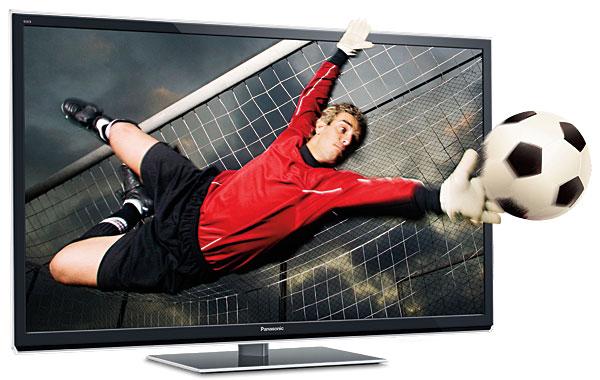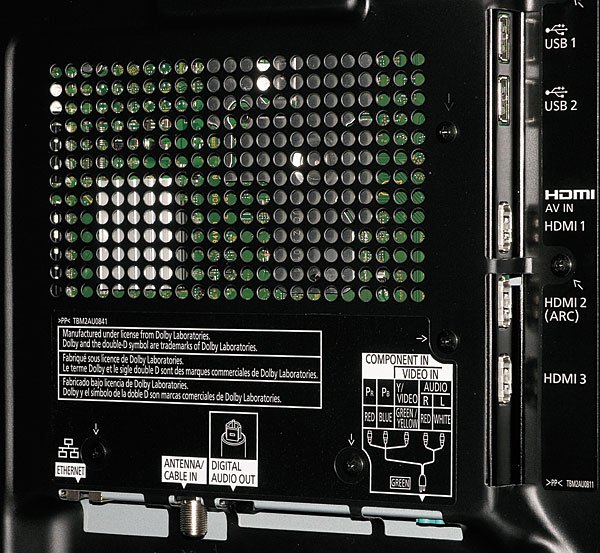I decided on the ST50 after... over a year? of trying to decide on a new hdtv. Can't wait for it to arrive!
^______^

HDTV manufacturers’ fortunes have been in a perpetual state of flux for years. With prices continually dropping, profit margins are slim. While the TV makers haven’t quite yet adopted a business plan that calls for losing money on each sale, there isn’t much further they can go without them paying you to take the set home. Just kidding, of course. But apart from the dicey economy (or perhaps because of it?), this is a golden age for the consumer to buy a great HDTV for not a lot of cash.
Of course, if your paradigm for a reasonably priced TV is $300, you need to move on into the 21st century; $300 or so was the going price for a clunky, 19-inch standard-definition color set circa 1975. But at today’s $1,700, Panasonic’s new TC-P55ST50 Plasma 3D HDTV is the real deal. And if you can’t stretch that far, you can have the 50-inch version for $1,400 suggested retail, before discounts.
Around the Block
Panasonic’s printed user manual gives basic setup advice, but little else. There’s more detail in the onscreen Help menus, but even these are incomplete, amusingly unhelpful (example—“Contour emphasis: Adjusts the Contour emphasis of the image”), and sometimes misleading (the descriptions of the HDMI/DVI RGB range). But such things are not unknown to those printed manuals that are rapidly disappearing in our cost-conscious-, use-the-bits-, save-the-trees-crazed culture.
The TC-P55ST50 has five Picture modes: Vivid, Standard, Cinema, Game, and Custom. These can be separately adjusted, but only the Custom mode can be adjusted separately for each input. All of the modes provide for separate settings for 2D and 3D.
Unlike more upscale sets in Panasonic’s product mix, the ST50 models are not THX-certified, nor do they offer ISFccc features.
The available adjustments vary with the selected Picture mode, with Custom offering the widest range of options in its Pro settings menu. These include Color space (Wide/Normal—actually this is color gamut—and you’ll want Normal if you use Custom), high and low W/B (white balance) adjustments, Panel brightness (Low, Mid, High), a Gamma adjustment (none of the six selections by measurement matched their numbered gamma settings), Black extension, AGC, and Contour emphasis. This Pro settings menu is available only in the Custom Picture mode. The only Pro adjustments I really missed in the other modes were the white balance and (had they been more accurate) the gamma options.
An HDMI/DVI control selects the video brightness range—either so-called Standard (16-235), Nonstandard (0-255), or Auto. The full digital video brightness range is 0-255, and while computers use all of it, consumer video sources limit themselves to 16-235 to provide headroom and footroom. But the correct range for a display is 0-255. Setting 16-235 will clip off any video material in the overflow ranges. I obtained the best results, with no unwanted clipping, with this control set to Nonstandard and the set’s Black level control set to Dark—for both 2D and 3D.

The Color temp. control offers five settings; you’ll want Warm2. Ignore the others. The Color mgmt. (management) control is no such thing; it has only On and Off positions and is said to “enhance blue and green color.” I left it off. C.A.T.S. adjusts the image brightness for the room conditions. Ditto, Off.
A four-position Motion smoother feature in the Advanced picture menu reduces motion blur. The control’s effect is most pronounced on diagonal or vertical motion. But as with all similar controls, this one can make film-based sources look like video—the soap opera effect. Motion smoothing is less necessary on a plasma set, which has less image lag to begin with, than on an LCD. I might be tempted to use Motion smoother on live sports, but I definitely avoid it on films.
The TC-55ST50 can connect to the Internet either directly or through your home network—wired or wirelessly. Viera Connect then gives you access to a wide range of Internet sites that Panasonic has partnered with—including YouTube, Netflix, Skype (optional camera required), Hulu Plus, Vudu, WSJ Live, Cinema Now, and much more. There are also dozens of free or low-cost applications you can download. You can check the image from a video camera (not included) located anywhere in the house and linked to the set through your home network.
In addition, you can view still photos, full-motion images, and music through a connection to your home network or from a USB device or SD card. This includes compatible 3D content you may have captured on a 3D still or video camera.
I’ve found that the Panasonic plasmas I’ve tested have been moderately prone to temporary image retention—most visible on a black screen as dim ghosts of pictures past. The same was true here, but the ghosting faded fairly rapidly with no further action required on my part. And it never interfered with normal program material. The set also offers selectable anti-image retention features. These include a Pixel Orbiter that automatically moves the image imperceptibly, an adjustment for the sidebar brightness on 4:3 sources, and a scrolling bar that can help clear temporary image retention. There’s no need to be paranoid about this, but it’s smart to be extra careful during any plasma’s first 100-200 hours of use—particularly with fully stationary images, moving images with segments that don’t move (such as scoreboards on sports broadcasts or video games), images that occupy less than the full screen (4:3 or 2.35:1), excessively bright, opaque TV station bugs, and all 3D images. (It’s easy to forget that 3D can be far brighter on the screen, and therefore more likely to produce image retention, than properly adjusted 2D. The 3D images you see appear dimmer largely because of the way 3D glasses operate.)
The set’s HD size and H size controls would be more clearly described as overscan adjustments. Each of them offers two settings. Normally, I’d recommend setting these controls to Size 2, which eliminates overscan (no overscan = pixel-perfect). However, I saw occasional gray lines along the outside edges of dark images in this setting. They were caused by the action of the Pixel Orbiter feature. To eliminate them, I turned Pixel Orbiter off (it’s on by default). You can select Size2 instead, which will also hide the lines, but does so by introducing 2.5 percent overscan on all sides.
To watch 3D on the TC-P55ST50, you’ll need Panasonic’s active 3D glasses ($80 per pair, not included). The IR transmitter that activates the glasses is built into the set. The Panasonic switches to 3D auto- matically when you send it a 3D source. It should automatically select the correct 3D mode, but these can be chosen manually if needed. The set also has a 2D- to-3D conversion mode that works about as well as most, which is to say the kids might like it.
2D Performance
The TC-P55ST50 disappointed me only in the smallest of ways. Specifically, it’s no Pioneer Kuro (RIP), but if you think it should be, you don’t get out much. Its video processing is good (see Video Test Bench) but doesn’t do too well on 2:2 sources—a common failure on many sets.

I decided on the ST50 after... over a year? of trying to decide on a new hdtv. Can't wait for it to arrive!
^______^

Change the set to 48Hz mode in 3D and you will eliminate the minor ghosting.

I agree with dobyblue with the 48Hz mode, the 3D picture is free of crosstalk, it is pretty close to perfect. The same for others models of Panasonic . GT25, VT25, ST30, GT30, VT30, GT50 and VT50. check it out.

Thanks for the review of the ST50
I purchased two Pioneer KUROs, the PDP-6010FD and the 6020FD a few years ago. Very much appreciated the Sep 08 review.
Now I have just purchased the panasonic TC-P55VT50 two weeks ago on amazon for $2000.00, not much more then the ST50.
I waited all these years until a set was nearly as good or better than the Kuro's since I am cascading the tv's down to other rooms. Still need a couple more.
But I wonder whether the VT50 is a better replacement than the 6020FD? It seems close, and a thorough review would be great. I can't do a side by side comparison, but it does appear the color in the Panasonic are better.

I am interested in this topic and would like to find out some more information as my friend need information on this topic. Do you have any other articles about this?
IT Support in Sussex

hello.
I am very happy with the purchase of my tv panasonic GT50, but I have a concern about the image retention. Although I have been very careful with these first months, not yet complete 100 hours of use, but I've noticed especially that with only two hours of use on channel foxhd, the logo has been printed on a little screen ... and has been declining, but what do you recommend caution to avoid these problems in the future? ...
Thanks !!